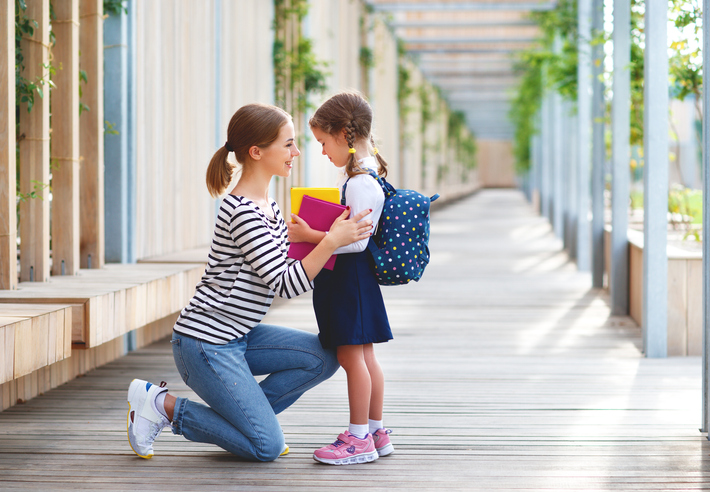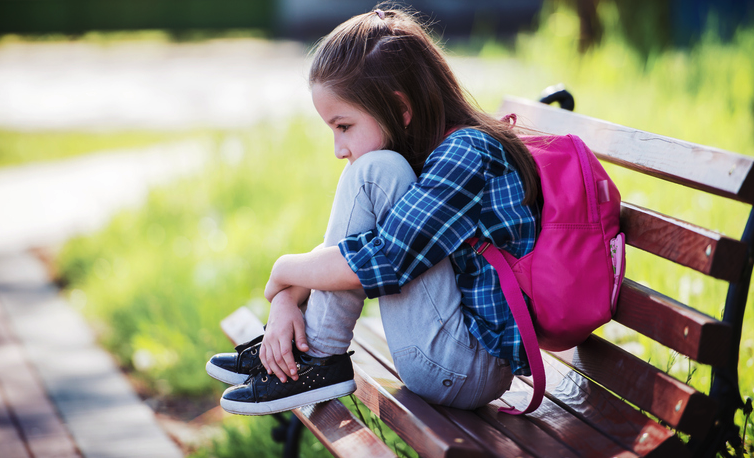The start of a new school year is exciting for most kids, but for some it can spark nervousness and worry. Back to school anxiety is especially common during transition years when kids are starting preschool, kindergarten or middle school for the first time or moving to a new school.
For most children first-day jitters are perfectly natural, and any fear of school a child has will fade over time as they get used to the rhythms of the day.
Although it’s normal for your child to have some back to school anxiety, it’s also important that they attend school in spite of any worries they have.
Avoidance will only reinforce a child’s fear of school over the long term and make it more difficult for them to go back. An outcome you definitely don’t want.
RELATED: 9 Tips For Helping Kids With Anxiety
Therefore, the goal of parents is to be supportive and find ways to ease back to school anxiety symptoms during the transition period.
Below are some general anxiety tips and strategies parents can use when dealing with school worries.
The good news is that most young people adapt well, and you should expect to see their back to school anxiety levels return to normal within the first month.
7 Tips To Help Ease Back To School Anxiety
1. Eat And Sleep
Nobody handles stress well when they’re hungry or tired.
Anxious kids often forget to eat, so be sure they get a good breakfast before heading out and pack them plenty of healthy snacks to see them through the day.
Excitement and worry can also affect sleep, and getting a good night’s rest is important in helping kids cope with back to school anxiety.
In the evening acknowledge your child’s excitement and trepidation about school, then try giving them some warm milk. This old-timey sleep aid works because it releases tryptophan, which helps with sleep.
You can also try reading a familiar and comforting bedtime story.
Other sleep inducing tricks to try include gentle music, ambient lighting, and keeping the temperature in your child’s bedroom on the cool side.
2. Establish Regular Routines
Having a consistent morning and night time routine makes life more predictable, which can significantly reduce anxiety in kids.
Ideally you want to start reinstating routines before the school year actually starts, to get your child used to the structure.
RELATED: Tips To Rock Your Morning Routine And Get The Kids To School… On Time!
A regular morning routine helps ensure that you or the kids aren’t running around looking for things, which can cause more stress. It also gives everyone time to sit and eat.
A regular evening routine eases kids into bed and can help them fall asleep faster. And as we mentioned before, a well-rested child is better able to handle school stressors.
3. Be Prepared
Like with any new activity, a new school year is easier when you’re prepared for it. Get your child’s class assignment and schedule in advance if you can and talk with your child about it.
Make sure your kids have all the supplies they’ll need and get them involved in the back-to-school shopping. Sometimes the excitement of a new backpack or outfit can help with first-day jitters.
RELATED: Amazing Children’s Books About Anxiety Help Overcome Worries
If you anticipate your child will be extra nervous, it helps to do some ‘test runs’ to give them an opportunity to get used to their new school in advance. Familiarity can reduce signs of anxiety
Walk or drive to the school (however you plan to get there) several times before school starts. Let your child see the buildings and the drop-off area ahead of time.
If you can, walk around the campus and locate your child’s classroom, the bathroom, playground, cafeteria, etc. This will help them feel comfortable being there.

4. Talk About Worries And Empathize
Change is never easy, and it can often be scary. It’s pretty normal for kids to have worries about their upcoming school year.
What you don’t want to have happen is for your child to bottle up those worries inside and dwell on them, making them worse.
Set up a regular time and place during the first weeks of school where your kids can talk and get your undivided attention.
It’s important to really LISTEN to what your child is anxious about and acknowledge their feelings. Don’t dismiss their feelings as being invalid.
Telling your child not to worry about whatever fears they might have isn’t helpful, because it leaves them alone with the worry. Contrary to what many grown-ups believe, a child’s worry won’t magically vanish because you say “don’t worry, everything will be fine!”
If kids don’t feel like their worries are being taken seriously and understood, they’ll stop verbalizing them…which can then make them worse.
Instead hear them out. Say things like “I know that’s hard” or, “I get it, I worried about that too in kindergarten”.
By listening with an open heart and empathizing, your child will feel more secure and be reassured that they’re not alone.
5. Help Problem-Solve
Once you’ve heard and validated your child’s feelings, you want to demonstrate confidence in their ability to handle the situation.
Rather than saying “that will never happen”, encourage your child to think of ways to solve the problem if it did.
“If you do get lost, what could you do?” Or, “if someone is mean to you, what could you say?”
It’s important to keep in mind that not all problems can be handled by your child alone. Some problems, like bullying or learning disabilities, may require adult intervention.
RELATED: Parent Alert – Possible Signs Your Child Is Being Bullied
So when discussing back to school anxiety solutions, be sure that talking to a teacher or parent about a difficult situation are always one of the options.
6. Focus On The Positive
Try to redirect your child’s attention away from things that cause worry, and towards parts of school that are exciting or fun.
Ask your child questions like, “what are you looking forward to at school?” to get them thinking about the good things that can happen.
Even if the only answer they can come up with is playing at recess or pizza at lunch, at least now they’re thinking about something fun.
Sometimes the good parts of school can get overlooked by repetitive worries. Bring the positive parts back into the conversation.
7. Check Yourself
Parental anxiety can affect children. So pay attention to your own behavior!
Your kids look to you for how to act. If they see you’re confident and comfortable with the new situation, they’re less likely to be afraid.
When you drop them off be supportive, yet firm. You only need to say goodbye once.
If you reward a child’s whining, crying, or protests by coming back or allowing them to cling and stay with you, you’re not helping them transition.
So put any back to school anxiety you may have on the back burner until after your little ones are safely in class. There’s always time for mom tears when you’re alone in the car.
Know When To Get Help
Like we said, back to school anxiety tends to drop naturally over the first few weeks of school.
You can always check in with your child’s teacher to see how they behave after drop-off. If they bounce back and happily participate during the day, they’re probably going to be just fine.
If, however, your child continues to have full-blown separation problems, starts refusing to go to school, and/or demonstrates physical symptoms of stress like headaches and stomaches… something more than normal back to school anxiety is going on.
These could be signs of an anxiety disorder, learning problem, or other issue.
RELATED: Anxiety in Children -19 Things Every Parent Should Know
At this point, your child should be evaluated by a child psychologist or other mental health professional to help figure out the root cause of their worries.
It’s good to be proactive, because once a child starts missing school it gets harder for them to get back into the routine.
A specialist can help determine the underlying cause and come up with a treatment plan to get your child back into the classroom.
SHARE 7 ways to ease back to school anxiety on Facebook and Pinterest by clicking the buttons below.












